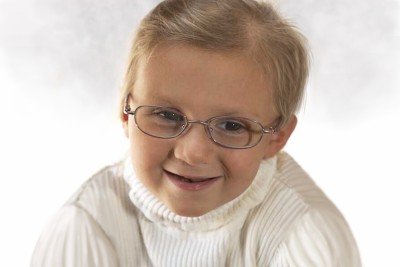Perry’s Story
Perry was born with retinoblastoma, the most common form of eye cancer affecting children. When she was two, she also developed a brain tumor. At Memorial Sloan Kettering, she fought through two operations, five cycles of chemotherapy, and one stem cell transplant before she even started preschool.

To meet Perry Zimmerman, you would think you’re meeting a typical, albeit cute and precocious, five-year-old. What you wouldn’t know was that Perry has faced and conquered more life-threatening obstacles in her short life than most people could even begin to imagine.
The Journey Begins
Perry’s father, Larry, had the inherited version of retinoblastoma, which is the most common form of eye cancer in children. Since each child of a parent with inherited retinoblastoma has about a 50 percent chance of being born with the disease, Larry and his wife, Anne, who was pregnant with Perry at the time, opted to have amniocentesis, a common prenatal test of the amniotic fluid, to see if Perry had inherited the genetic mutation responsible for the disease. The results showed that she did.
Beginning the day she was born, in May 2000, at New York Hospital, Perry was examined by David Abramson, then head of the retinoblastoma team at NY Hospital and now Chief of the Ophthalmic Oncology Service at Memorial Sloan Kettering. For the first nine months of her life, she received laser therapy to treat the retinoblastoma tumors, which, fortunately, were small enough not to require enucleation, a procedure that involves surgical removal of the eye.
Following treatment, “She had been tumor-free for months, and things looked really good,” says Larry Zimmerman. “We thought we were well on our way to putting this all behind us.”
Indeed, Perry was healthy and apparently cancer-free between the ages of one and two.
“She was full of energy and happy,” Anne Zimmerman remembers. “We went in for regular check-ups, none of which found anything.”
The Zimmermans knew that less than ten percent of children with inherited retinoblastoma may develop something known as trilateral retinoblastoma, a form of the disease that includes the development of tumors in the brain. “But,” says Anne, “we were under the impression that it was so rare that we weren’t expecting Perry to develop it.”
All Hell Breaks Loose
In spring 2002, for more than a week, Perry started exhibiting some strange behaviors. She became extremely lethargic, and her walking gait became bow-legged. Finally, when the behaviors weren’t going away and Perry started to develop a frequent headache, the Zimmermans took her to the emergency room. “Even then, we didn’t expect it to be anything serious. Maybe just a bad virus,” Anne explains.
They learned that it was more than “just a bad virus,” when, later that night, they received the results of a CT (computed tomography) scan, which showed that Perry had a brain tumor. The frequent headaches were caused by a condition known as hydrocephalus in which the cerebrospinal fluid within the skull can not drain and swelling occurs in the brain. It was
“That was the moment when all hell broke loose,” Larry recalls, shaking his head. “It was the middle of the night. We were told that our daughter had a brain tumor. We didn’t know it then, but she was in really bad shape.”
The very next morning, Mark M. Souweidane, a pediatric neurosurgeon at New York Hospital with a joint appointment at Memorial Sloan Kettering, performed surgery to relieve the swelling. “And the next day,” Larry says in astonishment, “Perry was sitting up in bed, singing songs.” The doctors told the Zimmermans that the pressure had most likely been building for at least a month. “When it was finally released,” Larry continues, “it was such a tremendous physical relief. She was happy, and we were crushed because we were still trying to comprehend the news that she had a brain tumor. The gravity of the situation was tremendous. Nobody was giving us any good news. There was nothing for us to hold onto.”
Desperate Decisions

The Zimmerman family
The doctors at New York Hospital told the Zimmermans that Perry would immediately need major surgery to resect, or remove, as much of the tumor as possible. Four days later, Dr. Souweidane performed the eleven-hour surgery. They had been told before the surgery that even with the procedure, Perry had a less than ten percent chance of surviving.
This left them with a critical decision of choosing the best treatment program.
Both Anne and Larry began to seek every bit of information they could find on the latest treatment protocols for trilateral retinoblastoma, making dozens of phone calls and spending countless hours on the Internet. Through their diligent, desperate research, they discovered that, at the time, there were a few patients in the world who had received an intensive treatment protocol that included five chemotherapy cycles followed by a stem cell transplant — which would have to be enough evidence for the Zimmermans.
“That’s how you help save your child,” Anne says matter-of-factly. “You do your research. You have to make sure that your child is getting the optimal treatment protocol. You have to understand all the treatments and drugs. Some parents choose not to do this, but I believe that, as parents, you do have influence over the outcome, especially in choosing where and how your child will be treated.”
Once the treatment protocol was chosen, the next decision involved where to send Perry for treatment, a decision which came down to three hospitals: one in Toronto, one in Philadelphia, and Memorial Sloan Kettering. For a number of reasons, including the experience of the staff, the close proximity to their home, and the close connection with Perry’s doctors at New York Hospital, they chose Memorial Sloan Kettering.
Treatment Begins

Perry and her brother and sister
Perry started on chemotherapy under the care of Ira J. Dunkel, a pediatric oncologist at Memorial Sloan Kettering who specializes in brain and eye tumors, and Yasmin Khakoo, a pediatric neurologist also at MSK. During all of her initial MRI (magnetic resonance imaging) scans, her tumor appeared to be shrinking. Within the first week of Perry’s illness, the Zimmermans, in their research, discovered a protocol that included the use of intrathecal medication — a process in which cancer-fighting drugs are injected directly into the fluid-filled space between the thin layers of tissue that covers the brain. At the time, this was not Memorial Sloan Kettering’s standard retinoblastoma treatment approach, but the Zimmermans convinced Dr. Dunkel and Dr. Khakoo to petition MSK’s research board to include it in Perry’s treatment. Dr. Dunkel received the board’s approval, and Perry started receiving intrathecal medication at the start of her fourth chemotherapy cycle.
“Dr. Dunkel and Dr. Khakoo were both so great throughout this entire very trying process,” Anne notes. “We felt that they cared so much for Perry and we knew they would do their best to treat her.”
After the fifth cycle of chemotherapy, before the stem cell transplant, Dr. Souweidane surgically removed any residual tumor. During the seven-hour procedure, the Zimmermans were relieved to learn that the doctors found no active cancer cells remaining.
Larry remembers what a wonderful patient Perry was throughout all of these harrowing procedures. “She was perfect throughout it all. And, in a way, she was the ideal age, where we could spin everything that was happening, saying ’Aren’t those nurses great?’ and ’Aren’t all these tubes and machines fascinating?’”
“We were used to being at the hospital,” Anne adds. “We’d spent so much time there, we were comfortable in that environment. In a strange way, it was more difficult adjusting to going back home.”
One Final, Life-Threatening Obstacle
Unfortunately, before Perry could go back home, she encountered one more imposing obstacle. During her stem cell transplant (which followed the high-dose chemotherapy regimen that weakened her blood-cell- and immune-cell-producing capacity), Perry developed pneumonia — at a time when her immune system was compromised and unable to fight it.
Doctors at MSK rushed her across the street to New York Hospital, where she was placed in a medically induced coma and put on a ventilator for 19 days. The Zimmermans were told by the doctors that they doubted Perry would live through this latest trauma. Both of the Zimmermans remember the experiences of this time as being devastating.
Fortunately, toward the end of the 19 days, Perry’s immune system began to recover enough to fight off the virus. It happened to be the week of Christmas, and though they spent it in the hospital, Anne and Larry remember it as their best Christmas ever because Perry became well enough to be taken off the ventilator and removed from the induced coma.
In the wake of her 19 days on a ventilator, Perry could not initially walk or talk due to the stress and muscle deterioration. But within four weeks she had recovered her pre-coma functions, although it took a while for her to get her strength back.
With Cancer Behind Her and a Whole Lifetime Ahead
Perry started pre-school in the fall of 2003 — just eight months after she had finished her treatments at MSK — and is now thriving at Resurrection Episcopal Day School (REDS) in Manhattan. In her new school, she has developed a very special bond with Laurie Boone Hogen, head of REDS.
Ms. Hogen comments: “Perry is a model of courage, compassion, competence, and confidence. After surviving a substantial life and near-death experience at a very young age, Perry has developed an incredible inner strength and has made up her mind to live a full life and realize her considerable gifts. She is an intelligent, joyous child, full of academic potential and an appreciation of life.”
Perry continues her check-ups and undergoes diagnostic scanning on a regular basis, and she has had no trace of cancer since completing her treatments in January 2003.
“She’s just been great,” Larry says with a deep sense of relieved appreciation.
“I think we’re so much better as a family because of this experience,” he continues. “After everything we’ve been through, we have a completely different outlook on life. We felt like we were pretty grounded before, but an experience like this truly puts life into perspective.”
And Anne’s final piece of advice to other parents is clear and succinct: “If there’s anything you can do to help ensure that your child is receiving the best treatment that’s available, do it.”
If one has any doubt about the outcome of such advice, one need look no farther than bright, adorable, and vivacious Perry Zimmerman.




